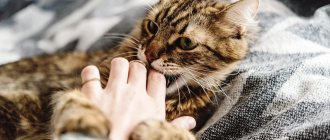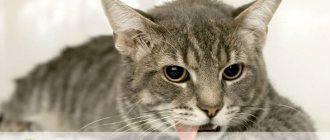- Cats
- General issues
More often we see our pets in good health and good mood, but sometimes the animal has tears in its eyes. Why do cats cry? Tear discharge in cats has nothing to do with bad mood. According to scientists, animals are not capable of expressing human emotions. A cat may be sad or feel joy, but this will not be expressed by wild laughter or bitter crying, such feelings will spill out in another form. When a pet experiences negative emotions, it will meow pitifully, howl in pain, scream at night, but not cry like a human being. Animals don't tend to cry just like that. If your pet has tears in his eyes, it means there is a specific reason.
Can cats experience emotions?
“Do animals have consciousness?” - a question on which scientists cannot come to a compromise. Emotions make mammals similar to humans. It can be said that basic emotions such as fear or anger are biologically primitive and the same across all species. Some experts believe that there is no division of emotions into basic and secondary. Therefore, it is possible for animals to feel all human emotions.
A sad cat means grief in the family!
Cats cry, but not like people
If your cat's eyes are watery, 99% of the time it is due to injury, illness, or severe anxiety.
A cat's eyes may water, but this is not an emotional reaction. Cats don't cry like people. Watery eyes can be caused by irritants: disinfectants, household chemicals, allergies, etc. If your cat's eyes are constantly watering, it is better to immediately contact a veterinary clinic.
Cat tongue
To recognize your cat's mood, you need to observe her behavior and changes in posture. When the cat:
- lies relaxed next to you - the mood is good, playful;
- she lays down with her stomach up - you can pet her;
There is never enough love!
- sits with his back to you, does not respond to your name - it is better not to touch him, wait for a more favorable moment;
- arches his back, fluffing his fur - severe fear;
- in a curved position it becomes sideways - warns of an attack, is able to release its claws;
- pressed to the ground, ears stuck out, growling - very bad mood;
- looks into your eyes for a few seconds - greeting;
- peers for a long time - an invitation to communication;
- purrs - joy, harmony;
Love must not only be received, but also given!
- shifts from paw to paw - a manifestation of tenderness.
When to contact a veterinarian
Only a veterinarian can diagnose and accurately state the cause of this condition of cat's eyes, when a small amount of discharge accumulates in the corners of your cat's eyes. If this happens in the morning or after sleep - the phenomenon is quite physiological, the cat will wash itself, or you will help it with this - wipe the corners of its eyes with a napkin. But, if tearing occurs throughout the day, this is no longer a question of hygiene, but a question of disease, and your veterinarian can and should help you in this case.
- Dog
- Long-eared cats
- Cat meowing
- Alexandrian parrot
- Why does a cat need a mustache?
- Rescue dogs
Also, if you notice that your cat begins to constantly squint, or tries to rub its eye with its paw, this may also indicate that an infection has entered the animal’s eye, which means you immediately need to seek advice from specialists and do not wait until the eyes the animal will be filled with pus and it will stop seeing altogether...
Do cats cry?
Experts believe that furry couch potatoes can become severely depressed. Therefore, laws were introduced in Europe on the need to keep two animals of the same species. So that they entertain each other while their owners are away. But cats, due to strong emotions, cannot cry. An animal becomes apathetic and lethargic when it feels offended.
Important! If a member of the cat family experiences stress for a long time, is in an unusual environment, or suffers a strong shock, he may get sick! In this case, owners need to think about their behavior and devote more time to the “crying” pet.
Sadness can lead to serious illnesses!
When cats "cry" and scream...
Hello, attentive!
Today we will talk about such a phenomenon as cat screams and “crying” or, scientifically speaking, the vocalization of cats.
Spring is just around the corner, which means that in a large number of houses and apartments, feline sexual instincts will awaken, and the owner’s sleep will become restless. And it’s not just that the loud voices of anxious cats and kittens interfere with the rest of their owners and their neighbors. It would be nice if only this...
The fact is that the owners of mustachioed cats reverently experience the cat’s suffering almost as if it were their own. “Almost” - because sometimes the suffering of cats bothers their owners even more than their own.
Of course, the cat cries so much, screams so much, bends over and suffers so much! She's in pain, she's complaining so much! How could we help her, what could we give her right now so that she would shut up and we would stop worrying about her?!
Probably, in order to solve the issue of stopping cat screams and crying, it is worth understanding in more detail the nature and manifestations of cat vocalization.
Let's look at the reasons why cats vocalize. Do cats suffer as much during the manifestation of sexual instincts as their owners think? What other phenomena are hidden behind cat cries? Can cats “cry” not only from heat? How does a cat react to pain and does it “cry” when it really hurts?
Why does a cat need a loud voice?
If you look closely at the behavior of cats in a group, you will notice that cats use a loud voice only in exceptional cases. Each cat's vocal signal has a very specific specificity and is quite easily recognized by relatives and other attentive listeners.
What does a cat say in a loud voice?
- First of all, that she is ready to reproduce.
- About the approach of a stranger to the borders of his territory.
- That she is very dissatisfied with something.
- About demanding something from the owner.
- A sharp, sudden pain in the abdominal cavity, usually of a spastic nature.
- About the headache.
- About other causes of discomfort...
Let's take a closer look at some cat signals.
Cries of March cats
Sexual behavior of cats is accompanied by loud screams and “crying”, in a word, vocalization. This applies to both females and males. The female cat screams to announce that she is in heat, and the male cat announces that he is here, nearby.
As a rule, the cries of cats during the display of heat (readiness to mate) are very loud, “guttural”, not similar to others, except, perhaps, for some territorial warnings. Typically, sexual vocalization becomes most powerful when the cat is not exposed to other stimuli. This means that cats and kittens, excited by their own hormones and other people’s pheromones, scream loudest when other sounds fade away. Of course, these are night hours or other hours of rest for the owners and their neighbors.
Any strong sound or other irritant, such as a bucket of water from the window at the “grooms” gathered from all over the area, or a slipper flying into the vociferous “bride,” knocks down the “romantic mood” of the tailed ones, however, as soon as silence reigns, the “concert” resumes with new strength.
“Concerts” with several “vocalists” are especially striking. But even one cat in heat is quite capable of ruining the night life of the residents of several neighboring apartments.
Do animals that “scream” suffer because of sexual instincts? Yes, sure. But not from pain as such, but from those desires that overwhelm them, but are not realized. From overexcitation of the nervous system, when “you want something, but I don’t know who.”
The cat calms down after mating, at the end of estrus or after castration, which is often called sterilization. Remember that ineffective estrus that does not lead to pregnancy can lead to the development of polycystic ovary syndrome in the cat, purulent inflammation of the uterus and even breast cancer.
Cats, as a rule, “yell” if they smell the pheromones of a cat in heat or a rival cat. And if both are nearby, then the owners of such a cat can only dream of a good night.
Cat screams and crying associated with the manifestation of sexual instincts indicate overexcitation of the nervous system. This phenomenon is aimed at finding a sexual partner, and is not associated with pain, but with the implementation of the instinct of procreation.
Castration of a cat solves the problem of sexual vocalization. Chemical castration is temporary, surgical castration is once and for all.
Territory protection
Vocalization when protecting a territory is typical for cats, as they say, “free-range.” Cats give warning signals when an “intruder” comes close to the boundary guarded by the cat or violates it. As a rule, the cry of the cat who owns the territory is loud, short, and guttural. If the offender does not run away, then what follows is an attack and a fight “to the bitter end.”
You can distinguish sexual vocalization from territorial vocalization by the duration of the signals and changes in timbre. Territorial vocalizations are characterized by a higher end of the signal and a much shorter duration.
The same territorial signals can be given, especially “in the season,” by residents of city apartments, whose neighbors let their cats “walk” in the common corridor. In this case, sensing a stranger and being excited by the pheromones in the air, apartment cats can stage a “concert” and even write under the door of their own apartment so that the stranger on the other side of the door knows that the territory has an owner.
Cat cries associated with the protection of the territory are reminiscent of the warning cries of sentries. These screams are directed at an approaching enemy, usually one of their own species. They intensify against the background of exacerbation of sexual instincts, but can exist independently of them.
Discontent, threat, fear
If you accidentally step on a cat's tail or paw, you will definitely hear its displeased cry. This signal is very sharp, loud, ultra-short, designed to scare everyone who attempts to kill the cat. You will hear the same cry if the cat has already entered into a fight. Sometimes a cat makes the same cry during a game in the heat of intense excitement and aggression, usually towards its fellow tribesmen.
With this cry the cat tries to scare. It is important to remember that a cat is scary both when it simply wants to scare the one who is trying to kill it, and when it itself is very scared. This is one of the signs of cat aggression. The scarier the cat is, the more it will try to scare the enemy.
The cry of discontent, threat and fear is sharp, short, designed to frighten and drive away the enemy. It is always directed towards a specific object. The increase in such a cry is a signal of the animal’s increasing fear and dissatisfaction.
The extent to which the cat perceives the situation as dangerous for it can be judged by the strength and timbre of the cry. The louder and shriller a cat screams, the more dangerous it perceives the situation to be. But the nature of the cry must be compared with the nature of the cry of this particular cat in other conditions. Then the signal will be more clear to you.
Demanding cry
A cat makes such a cry specifically in relation to a person. This is an assertive, demanding cry, most often without shrillness. Sometimes he seems grumpy, clearly expressing feline dissatisfaction with the situation. Each next round of demanding screaming may be louder and/or longer than the previous one. As a rule, the tailed dictator tries to look you in the eye or even tries to bite the “stupid” owners on the legs. In some cases, a demanding cry is replaced or masked by a plaintive one, but the demanding notes always remain in it.
It is important to understand that the pet’s demand is aimed at obtaining a certain result - feed the dictator, play with him, go to another room, remove the odorous contents of the toilet, and the like. If you are sure that you understood your pet correctly, then decide for yourself whether to obey the beast’s demands or not.
Know that if, in a situation where everything is clear and the object of the demands is defined, the owner at least once succumbed to the demanding cry of the pet, then the tailed dictator will continue to use his demanding cry as a weapon of influence constantly. Until you get tired of obeying.
True, there are exceptions. If your pet’s demanding cry occurs in an atypical situation, you should definitely find out its cause. In a number of cases, it was with such a demanding cry that animals warned their owners about the danger that threatened them (fire, earthquake, stranger in the house, etc.)
A demanding cry is always addressed to a person. Its task is to force a person to act as your pet considers correct. If you do not want to obey the dictator’s demands that are understandable to you, then do not obey even once. If the requirement is “non-standard” and its reasons are not clear to you, try to establish them. Perhaps this will save someone's life.
Screams of spasmodic pain
When you look closely at the animal, these screams cannot be confused with anything. They accompany certain types of cat behavior:
- unsuccessful or ineffective attempts to urinate or defecate,
- gagging,
- changes in posture due to spasms of the intestines or gall bladder (adopting the so-called “prayer pose”).
These cries are similar to expressions of discontent. But there are also significant differences. The most important difference between these screams is that for the cat there is no external “addressee” of the screams; they seem to be directed into emptiness or “inward.” At the moment of such screams, the cat’s attention is directed not at an external enemy or an external source of danger, but inside itself. The animal does not seem to understand where the threat is coming from, but at the same time it reacts to the threat.
As soon as the spasm passes, the screams also pass. The animal calms down until the next spasm and the next attack of characteristic behavior, accompanied by cries of spastic pain.
Some of the animals scream loudly and plaintively, others very quietly. It is important to note precisely the “typical” nature of the combination of screams and behavior of the animal. And, if this is a repeated cry, then a trip to the doctor should be scheduled in the near future. If the frequency and/or intensity of screams increases, and the pet’s condition worsens, this is a reason to urgently consult a doctor.
Screams and crying of an animal as a result of spastic pain appear against the background of the same type of pet behavior or while taking a certain specific position (for example, for defecation or urination)
It is very rare, but it happens that similar screams “standardly” accompany the process of urination or defecation (stool) in a healthy animal. In order not to pay attention to such behavior and not harm your pet, you need to consult a doctor and make sure that your pet really does not experience health problems, and “sings songs” simply out of habit.
Oh, my head hurts...
It also happens that cats suffer from increased cranial pressure.
This happens most often in cats with chronic kidney disease (CKD), which was previously also called chronic renal failure (CRF).
Less commonly, headaches can be caused by brain tumors, impaired outflow of cerebrospinal fluid from the ventricles of the brain into the spinal canal, injuries to the brain and cervical spine, and some other neurological problems. In addition, rapid intravenous infusion of drugs (colloquially “drip”) can cause an increase in cranial pressure.
When a cat has a headache, it starts screaming. At the same time, the owners often look at the cat’s gaze or gaze directed “inward.” The animal usually holds its head at the level of the withers or below. The screams are monotonous, quite loud and strong, and may be accompanied by panicky movements, often meaningless. The duration of each cry can be long or short, but the important thing is that it is the same. The animal practically does not react to the voice and caresses of its owners and behaves like a robot. Some calm down in the arms of their owners, but not for long. The screams soon resume with renewed vigor and standard monotony.
If your animal exhibits this behavior, take your animal to the doctor immediately. As a rule, the doctor analyzes the patient’s neurological status, checks his pulse,, if possible, measures his blood pressure and recommends measures to improve the condition of such a severe patient.
In the case where the pet’s behavior has changed to restless precisely during the “drip” process, the rate of intravenous infusion must be urgently reduced. If necessary, medications that lower blood pressure are used. If the animal’s condition becomes similar after several intravenous infusions, then this is a reason to adjust the treatment. Be sure to discuss your pet's new symptoms with your doctor.
Intravenous infusion of drugs or “drip” should be carried out at a rate that is safe for the patient. For cats suffering from kidney disease, this rate is extremely low. Increasing the rate of intravenous infusion can cause increased cranial pressure and, as a result, headache in the patient.
Remember, with such phenomena, diagnosing the causes of headaches is very important. As a rule, in this case, blood tests are required, and ultrasound and even MRI are often required. It is impossible to treat without a diagnosis.
Causes of a cat screaming from a headache can be increased cranial pressure as a result of chronic kidney disease, tumors or injuries to the brain or cervical spine, or other neurological disorders.
Very similar behavior can be observed in older animals. Such cats and cats, at the age of fifteen years and older, change their behavior and begin to vocalize at approximately 3-4 o'clock in the morning. During the day, such patients often behave quite calmly and sleep more often.
I would recommend that the owners of such animals examine them for CKD, which can sometimes occur in a latent form for quite a long time and manifest itself only in such “night cries.” Well, if there are no kidney or other health problems, then you can try playing with the old people during the day and in the evenings, so that they can rest at night and not sing songs.
As a conclusion
We, of course, have not listed all the reasons for cat “crying” and screams. We didn’t touch on just “those who like to talk” at all.
But we think that it has become clear to you that an unambiguous interpretation of your pet’s vocals is not always possible. Therefore, before interpreting the meaning of the sounds made by your pet, especially if they are screams or “crying,” consult a specialist.
Remember that an animal living with CONSTANT pain will most likely NOT scream or cry AT ALL.
If a pet does not scream or cry, this does not mean that nothing hurts.
Be attentive to your pets' behavior. Pay attention to the sounds they make, their appearance, intensification and disappearance. Try to understand what exactly your four-legged friend wants to tell the world, do not be shy or lazy to contact worthy specialists.
After all, it is very important to help your pet on time.
Natalya Troshina, veterinarian (DVM)
Why the cat cries: reasons
Scientists have proven whether domestic cats can cry for physiological reasons. Here are some of them:
- Tears appear to naturally moisturize the eye (protecting the cornea from drying out and contamination).
- In breeds with bulging eyes (round slits), the mucous membrane is constantly involuntarily moistened.
Some breeds are prone to eye diseases.
- Possible obstruction of the nasolacrimal duct (when all the fluid comes out).
- Conjunctivitis (inflammatory process in the outer layer of the eye).
- Protrusion (prolapse of the third eyelid).
- Eenropion (turning of the eyelids).
- Corneal sequestration (a disease found only in cats, caused by tissue necrosis).
- Uevitis (internal inflammation of the eye).
- Glaucoma (increased intraocular pressure).
Features of some breeds
The flow of tears from the eyes, which is often found in purebred cats, is not at all the norm for them. Due to their physiological characteristics, Persians, Scots, Britons and cats of some other breeds suffer from teary eyes more often. However, with proper care for your four-legged friend, his eyes will be clean and clear, like all healthy cats.
Why do Scottish cats have watery eyes?
Scottish Fold cats have a specific skull structure. They have a short, snub-nosed muzzle. The tear ducts are very short. Therefore, whenever there is any irritation, tears flow easily from the eyes. If the discharge is clear and not very abundant, you should treat it as a breed characteristic and regularly care for your pet’s eyes.
Video
What to do and how to treat?
When a cat cries, and you notice, in addition to this, other alarming symptoms, you need to immediately contact a veterinarian. Animals do not know how to complain, but they are able to show their state of health through their behavior.
Monitor your pet's condition carefully!
Possible methods of treatment for diseases:
| Diseases | Treatment |
| Obstruction of the nasolacrimal duct | Daily care (washing the eyes with a special gel), therapy with antimicrobial and anti-inflammatory agents. |
| Conjunctivitis | Therapy with local antibiotics and antiallergic agents. |
| Protrusion, Enropion, Corneal sequestration | Surgical intervention. |
| Uevit | Prescribed depending on the cause of the disease. |
| Glaucoma | Therapy with drugs to lower intraocular pressure. |
Lethargic behavior may be the first warning sign!
Important! Do not engage in self-diagnosis and self-medication! It is necessary to contact a veterinarian in time to begin treatment in the early stages of the disease. Be careful and monitor changes in your pet's behavior.
How to deal with lacrimation in a cat
When faced with increased lacrimation in a cat, the main thing is not to waste time and prevent infection of the irritated mucous membranes. If you are unable to see a doctor as soon as possible, before receiving professional help, try to alleviate your pet’s condition yourself.
Preventive agents for disinfecting mucous membranes can be purchased at a pet store. Usually the products are drops or solutions for wiping. If, for some reason, this option is not suitable for you, you can use the following as an antiseptic solution:
- Decoctions of herbs (calendula, chamomile, oak bark) for wiping the eyelids.
- A strong brew of tea for cleaning eyelids and soaking crusts.
- A weak solution of furatsilin.
The truth about cat tears
Cats' eyes will "water" or water for a number of reasons, but they are all medical, not emotional. For example, this could be due to eye irritation from a speck of dust or a scratch from another cat. Tears can also be caused by infectious diseases such as upper respiratory tract infections. Clogged tear ducts (believe it or not) can also lead to rupture.
Other possible causes of a cat's watery eyes:
- Conjunctivitis (pink eye)
- Infections
- Allergies
- Structural problems (cats with rounded heads are more prone to tears)
If you see a cat crying, it is important to know that it is not expressing strong emotions. Instead, they show you that something is medically wrong. Often the problem is minor. However, in some cases, cat tears can be an indication of a serious problem or something that could become serious without treatment.
If lacrimation occurs regularly, it is recommended to visit a veterinarian. Strokes and kindness—while always appreciated—will not stop your cat from crying.
Cat emotions are real
Researchers have discovered that cats do have emotions. They can read people's facial expressions and can experience a wide range of feelings towards people and other animals. When they have feelings, they can act on them. For example:
- A happy cat may purr, rub, play, or otherwise interact with people and other animals.
- A sad cat may go out, lose its appetite, or become less energetic.
- An angry or frightened cat may hiss, arch its back, growl, or smack a person or other animal.
Cats that are anxious, angry, or upset may make sounds similar to human whining or whimpering. These sounds indicate the cat's emotions - and in this sense, the animal is crying. But according to researchers, humans are the only animals that cry when they experience strong emotions or pain.











